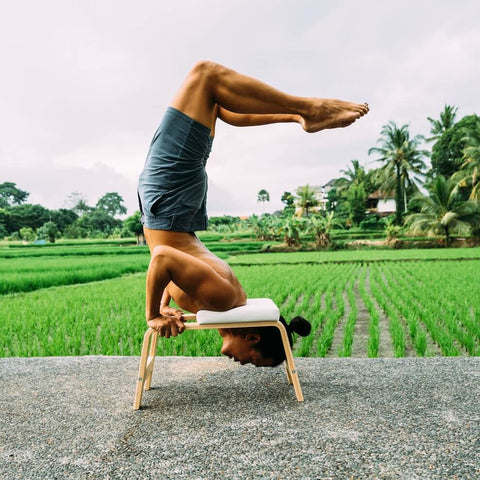An inversion is any pose in which your head is lower than your heart. One of the most fun parts of creating your own home practice is exploring what feels good when you move! There are countless ways to enjoy inversions with your FeetUp Trainer. Here are 3 exciting variations to try the next time you flip things upside down.
Remember: Only you know what is best for your body. Please take all of the information here as suggestions, move slowly, and only do what feels right for you.
Scorpion or Hollow Body

Quite similar to Scorpion Pose (Vrischikasana) or Forearm Stand, Hollow Body is an advanced posture worth exploring once you've developed sufficient core strength and body awareness in your inversion practice. This variation requires a lot of back flexibility while remaining balanced.
Beginner Pro-Tip: Simply begin by lifting your chin and looking straight down towards the ground while in FeetUp Asana. Avoid moving into the shape from the top down (feet first). Instead, work on keeping the core engaged and slowly lengthening into a deeper back extension.
Single Leg Foot Hook

This particular inversion is actually quite stable provided you've got the right type of flexibility and leg length to make it work! Starting in a floating pike (think upside down pachimottansana, more below), hook the top of one foot into the crossbar as you lean back and open the opposite leg up towards the sky. While it definitely requires a good amount of body awareness and comfort upside down, this pose can feel very relaxing once you've mastered the fine art of counterbalance.
Beginner Pro-Tip: Work on your flexibility right side up before trying this upside down. Spend a few minutes warming up your hips, legs, and back on the ground to get ready for this pose. Bear in mind that if you've got a long torso or shorter legs, it may feel quite impossible to hook that foot. Remember, this is a very decorative pose that looks a lot more fun than it is necessary.
Floating Pike

This pose is surprisingly easier than it looks and can feel amazing for people with tight shoulders and upper back. From a floating tuck (upside down with knees to chest), begin to let your hips travel back as you extend legs forward. Once you feel a grounded sense of counterbalance, you can try to tuck your chin and look up towards the ceiling. As you can tell from the photo, the shoulders are fully supported by the cushion and the hands are firmly gripping the frame. What you can't see is how the cervical spine (neck) is floating free and the practitioner's core is strongly engaged.
Beginner Pro-Tip: Put your FeetUp Trainer next to a comfy seat of your favorite couch and work on slowly rolling from Floating Tuck onto your back. This helps to build up the core strength and body awareness needed to find this floating balance in the middle of the room.



